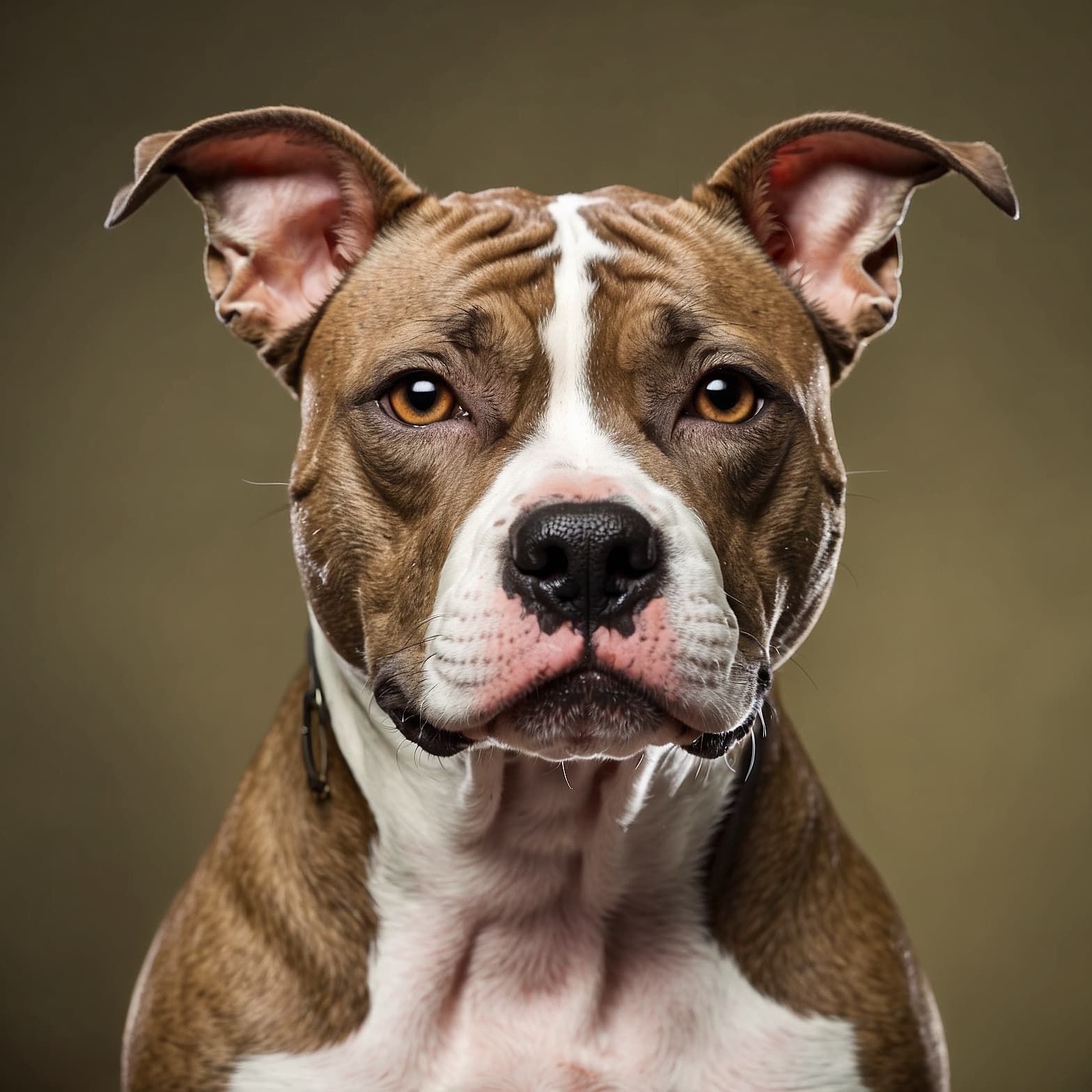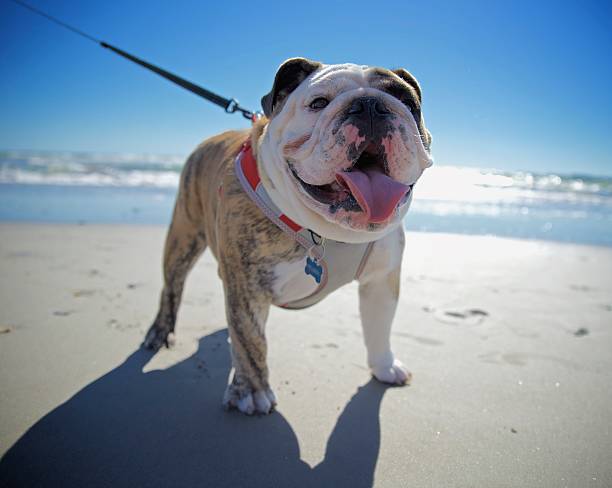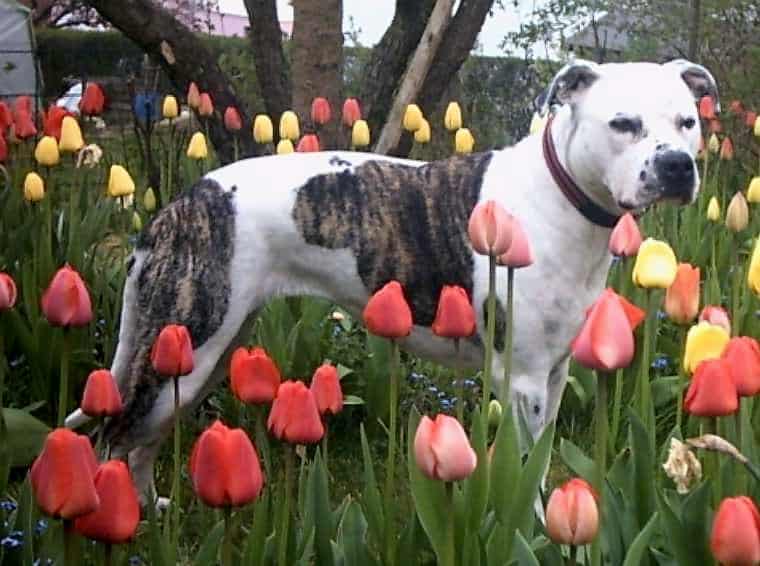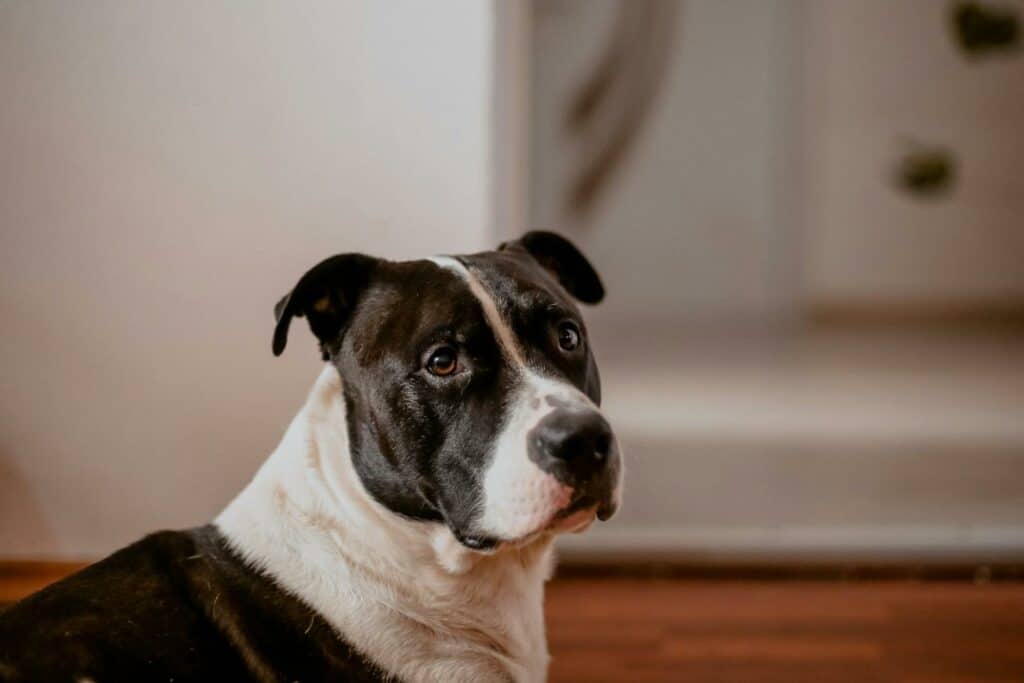Delve into the world of American Staffordshire Terriers, often referred to as AmStaffs. Learn about their storied history, their care requirements, and the loyalty and courage that define these remarkable dogs.

| Category (Explanation) | Breed Information |
|---|---|
| Year of Breed Conception | 19th century |
| Country of Origin | United States |
| Weight (lbs & kg) (Male) | 55-70 lbs (25-32 kg) |
| Weight (lbs & kg) (Female) | 40-55 lbs (18-25 kg) |
| Coat Type | Short and smooth |
| Color Variations | Various, often with a solid color or patches |
| Shedding Level (Low, Moderate, High) | Low to Moderate |
| Height (cm & in) | 17-19 inches (43-48 cm) |
| Breed Size | Medium |
| Trainability (Low, Moderate, High) | High |
| Mental Needs (Low, Moderate, High) | Moderate |
| Intelligence Level (Low, Moderate, High) | Moderate |
| Energy Level (Low, Moderate, High) | Moderate |
| Agility (Low, Moderate, High) | Moderate |
| Loyalty (Low, Moderate, High) | High |
| Playfulness (Low, Moderate, High) | High |
| Exercise Needs | Regular exercise and mental stimulation |
| Guarding Proficiency (Low, Moderate, High) | High |
| Sociability with Children (Low, Moderate, High) | High |
| Barking Level (Low, Moderate, High) | Moderate |
| Digging Tendency (Low, Moderate, High) | Low |
| Destructive Behavior (Low, Moderate, High) | Low |
| Drooling Level (Low, Moderate, High) | Low |
| Obedience Level (Low, Moderate, High) | Moderate |
| Apartment Friendly (Yes/No) | Can adapt to apartment living with sufficient exercise |
| Inherent Prey Drive | Moderate |
| Physical Risk to Others (Low, Moderate, High) | Low |
| Travel Fatality Risk (Low, Moderate, High) | Low |
| Allergen Potential | Low |
| Health Concerns (List of Common Health Concerns) | Hip Dysplasia, Skin Issues, Heart Conditions |
| Average Life Expectancy (Life Expectancy in Years) | 12-16 years |










































































Woof Mastery is reader supported and our articles may contain affiliate links.
Instead of running third party ads that we have no control of we only use links from high-quality companies we are directly partnered with. Making use of these links come at no cost to you our reader, and in many cases have the extra benefit of discounted rates or sign up bonuses.
If you’re interested you can read more about our affiliate policy here.
We appreciate your support and always insure that the products and services we recommend are high-quality, helpful and relevant to the subject at hand!
American Staffordshire Terriers, often referred to as AmStaffs, have a history rooted in the early days of American colonization. European settlers brought their working bulldogs to the New World in the 17th century. These versatile dogs were cherished for their assistance in hunting, guarding, and farm work. Over the centuries, American Bulldogs played crucial roles in helping settlers establish their homes and livelihoods. Their physical prowess, determination, and unwavering loyalty made them indispensable companions. They became known for their unyielding courage, even in the face of formidable challenges.

Delve into the world of American Staffordshire Terriers, often referred to as AmStaffs. Learn about their storied history, their care requirements, and the loyalty and courage that define these remarkable dogs. What makes them special is their unwavering loyalty, courage, and their role as devoted protectors and family members. American Staffordshire Terriers are special for their steadfast love and unwavering commitment to their owners.
American Staffordshire Terriers, often referred to as AmStaffs, have a traditional role deeply tied to their history as versatile working dogs. Originally, they were bred for bull-baiting, a blood sport that tested a dog’s bravery and strength. However, with the decline of bull-baiting, they transitioned to become loyal farm dogs and guardians. Their courage, loyalty, and protective instincts made them invaluable in protecting farms and families from various threats. Today, AmStaffs have evolved into beloved family pets, but their historical role as courageous and reliable working dogs continues to define their character.
American Staffordshire Terriers, or AmStaffs, are characterized by their courage and loyalty. They are known for their strong sense of duty and affection for their families. These terriers can be loving and protective. With the right training and socialization, they become devoted and dependable companions.
American Staffordshire Terriers, often referred to as AmStaffs, are known for their courage and loyalty. They are typically affectionate with their families and are renowned for their protective instincts. Proper training and socialization are crucial to prevent overprotectiveness and aggression towards strangers. They may exhibit territorial behavior, and their strength and size require careful control, making leash training a priority. Introductions to other dogs should be handled with care, especially with those of the same sex.
American Staffordshire Terriers, often referred to as AmStaffs, are medium-sized dogs with a well-proportioned and muscular build. They have a broad head, well-defined jaw, and expressive dark eyes. AmStaffs have a short, glossy coat that can come in various colors. Their ears are typically cropped or can be semi-pricked, and they have a short tail. They have a confident and powerful gait, reflecting their courageous and loyal nature.
American Staffordshire Terriers can come in various coat colors, including solid or patchy colors. Common coat colors for AmStaffs include red, blue, brindle, and fawn. These dogs may have white markings, and their coats are short, smooth, and easy to maintain. The variation in coat colors reflects their unique and lovable appearance.
American Staffordshire Terriers often have a short and glossy coat in various colors, including solid colors such as blue, fawn, or brindle. Some may also exhibit a white chest or markings.
American Staffordshire Terriers have a low shedding level. They have a short, smooth coat that is relatively easy to groom. Regular brushing helps keep their coat healthy and minimizes shedding. While they shed minimally, routine grooming and attention to their overall health can contribute to a cleaner coat. Overall, American Staffordshire Terriers are considered to be a breed with low maintenance in terms of shedding.
American Staffordshire Terriers have short coats that are easy to care for. Grooming habits for American Staffordshire Terriers include:
American Staffordshire Terriers have a high activity level. These energetic and muscular dogs require regular exercise to stay healthy and happy. Daily walks, playtime, and interactive activities are important for their well-being. They may excel in agility, obedience, and other canine sports. Mental stimulation is equally crucial, so consider incorporating puzzle toys and training sessions into their routine. Due to their strength and enthusiasm, it’s essential to provide them with outlets for physical and mental energy to prevent boredom-related behaviors.
American Staffordshire Terriers are intelligent and highly trainable. They possess problem-solving abilities and can learn commands and tasks with ease. Positive reinforcement methods, such as rewards and praise, work well in training these dogs. AmStaffs are known for their loyalty and desire to please their owners, making them responsive to training and forming strong bonds with their families. Their intelligence, coupled with a confident and affectionate nature, makes them adaptable to various living situations.
American Staffordshire Terriers thrive on mental stimulation. Engage them in activities such as puzzle toys, obedience training, and interactive games to challenge their minds.
Social Interaction: They are social dogs and need regular interaction with their human family members. Loneliness can lead to anxiety, so provide them with companionship and attention.
Exercise: Physical activity is not just for their bodies; it also benefits their mental health. Regular exercise helps reduce stress and anxiety in American Staffordshire Terriers.
Training and Obedience: American Staffordshire Terriers benefit from obedience training, which not only provides mental stimulation but also reinforces their bond with owners. Consistent, positive-reinforcement training is effective in shaping their behavior.
Routine and Structure: Dogs, in general, thrive on routine and structure. Establishing a predictable daily routine can help them feel secure and reduce anxiety.
Affection and Attention: Show affection and spend quality time with your American Staffordshire Terrier. They are known for their loyalty and need for human companionship.
Socialization: Early socialization is crucial to help them become well-adjusted dogs. Expose them to different people, animals, and environments to build their confidence.
Safe Environment: Create a safe and comfortable environment at home where they can relax and feel secure. Provide a designated space for them to retreat to if they need alone time.
Consistency: Consistency in training and daily routines helps them feel more secure and confident in their environment.
Enter The Woof Mastery

Prospective owners of American Staffordshire Terriers should be aware of their needs and characteristics. These dogs are known for their strength, loyalty, and affectionate nature. Early socialization and positive training are essential to bring out their best qualities. Regular exercise and mental stimulation are crucial for their well-being. Responsible ownership includes understanding breed-specific legislation in the area and providing a safe, loving environment. Potential owners should be prepared for grooming and committed to fostering a strong bond with their energetic and devoted companion.
American Staffordshire Terriers are known for their loyalty and affectionate nature. While they may face misconceptions, their risk to others is generally low with proper socialization and training. Responsible ownership, adherence to local regulations, and addressing any negative stereotypes contribute to a positive experience with this breed.
American Staffordshire Terriers are known for their friendly and outgoing nature. With proper socialization and training, they can be good with children. However, like any dog, interactions should be supervised, and children should be taught to respect the dog’s space and boundaries.
American Staffordshire Terriers may have varying responses to water. Some individuals may enjoy swimming, while others may not be as comfortable. Introduce them to water gradually and observe their comfort level. Always prioritize safety, and use a canine life vest if needed, especially in situations where they may be at risk of fatigue.
Remember that American Staffordshire Terriers thrive on positive interactions and consistent training. Building a strong bond through training is rewarding for both you and your Staffordshire Terrier.
Similar to the American Pit Bull Terrier, the American Staffordshire Terrier is not known for excessive barking. They are generally not considered noisy dogs. Proper training and socialization contribute to well-behaved and appropriately vocal dogs.
American Staffordshire Terriers do well in homes with responsible and committed owners. They thrive on positive interactions, regular exercise, and mental stimulation. A secure yard for play is beneficial. They can adapt to apartment living with sufficient exercise. Early socialization is crucial for a well-adjusted Staffordshire Terrier. Consistent training and positive reinforcement help channel their energy positively.
Traveling with American Staffordshire Terriers requires careful consideration of their size, strength, and energy level. Secure them in the vehicle using a crate or a seatbelt harness suitable for large breeds. Monitor for signs of stress or anxiety, and provide familiar items for comfort. Plan for regular breaks to allow them to stretch and exercise. Positive reinforcement can help create positive associations with travel.
American Staffordshire Terriers may be prone to specific health concerns. While not all individuals will experience these issues, it’s essential for American Staffordshire Terrier owners to be aware of potential health problems and work with veterinarians to maintain their pets’ well-being. Common health concerns in American Staffordshire Terriers include:
Regular veterinary check-ups, a balanced diet, proper exercise, and responsible breeding practices can help mitigate some of these health concerns. It’s crucial for American Staffordshire Terrier owners to work closely with their veterinarians to monitor their pets’ health and address any issues promptly.
Proper nutrition is crucial for the health and well-being of American Staffordshire Terriers. Here are some nutritional habits and best practices to consider for this breed:
Breed-Specific Laws (BSL): American Staffordshire Terriers may be subject to breed-specific laws (BSL) in certain areas. These laws are often enacted at the local or municipal level and can vary widely from one jurisdiction to another.
Types of Restrictions: The specific restrictions imposed on American Staffordshire Terriers under BSL can include mandatory spaying/neutering, special licensing, liability insurance requirements, muzzling in public, and, in some cases, bans on ownership. The severity of these restrictions depends on local regulations.
Rationale for BSL: BSL is typically implemented based on concerns about public safety and perceived risks associated with specific breeds, often due to incidents involving dog attacks. While American Staffordshire Terriers are not inherently aggressive, they can be affected by BSL due to their physical resemblance to breeds that are sometimes included in these laws.
Controversy: It’s important to note that BSL is a controversial topic. Critics argue that it unfairly targets breeds rather than addressing individual dog behavior and that responsible ownership and training should be emphasized instead of breed-specific restrictions.
Local Regulations: To determine if there are breed-specific laws or restrictions regarding American Staffordshire Terriers in your area, you should check with your local animal control or government authorities. Be aware of and comply with any local regulations to ensure that you are in compliance with the law while owning an American Staffordshire Terrier.
Woof Mastery is reader supported and our articles may contain affiliate links.
Instead of running third party ads that we have no control of we only use links from high-quality companies we are directly partnered with. Making use of these links come at no cost to you our reader, and in many cases have the extra benefit of discounted rates or sign up bonuses.
If you’re interested you can read more about our affiliate policy here.
We appreciate your support and always insure that the products and services we recommend are high-quality, helpful and relevant to the subject at hand!
Myth 1: AmStaffs are the same as Pit Bulls.
Myth 2: They are aggressive toward people.
Myth 3: They are dangerous dogs.
Myth 4: AmStaffs are not good with children.
Myth 5: They have a “locking jaw.”
Famous American Staffordshire Terrier owners include:
Jon Stewart: The comedian and former host of “The Daily Show” is known for his love of animals, including his American Staffordshire Terrier named Shamsky.
The American Staffordshire Terrier carries cultural significance in several domains:
While no specific historical owner stands out, American Staffordshire Terriers, like their Pit Bull counterparts, have been popular among various dog enthusiasts and owners for their loyalty and versatility.
American Staffordshire Terriers, like many breeds, have faced challenges and misconceptions:
The American Staffordshire Terrier shares a common ancestry with the American Pit Bull Terrier and has a history that involves a combination of various bulldog and terrier breeds. Some of the breeds believed to have contributed to its development include:
American Staffordshire Terriers bring a blend of strength, loyalty, and affection to families. Known for their friendly and tolerant nature, they can be excellent playmates for children. Their adaptability to different living situations makes them versatile companions. With proper socialization and training, they showcase their gentle side. As energetic and intelligent dogs, they thrive on interaction and activities with their families.